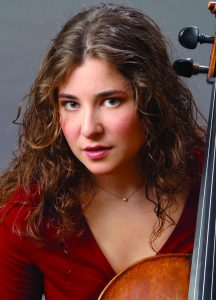Cellist Weilerstein Soars with Academy
On rare occasions, during a rapturous performance of great music, I am tempted to think that I will never again hear this work played so well. This has happened while hearing Yo-Yo Ma play an entire recital of J. S. Bach’s unaccompanied Cello Suites; Christopher Taylor play Messiaen’s “Vingt Regards sur l’Enfant-Jesus,” and recently when Gil Shaham performed Bach’s E Major Partita for Solo Violin.
Saturday (March 2) at the Balboa Theatre, cellist Alisa Weilerstein and the touring ensemble of the Academy of St. Martin in the Fields were only moments into Joseph Haydn’s familiar Cello Concerto in C Major when I came to that same conclusion.
The elite English chamber ensemble had just completed a passionate and lovingly detailed account of Benjamin Britten’s Variations on a Theme of Frank Bridge, that consummate valentine from the young Britten to his composition teacher. I was already savoring the Academy’s glowing tone, immaculate precision, and effortless ensemble when the 29-year-old cellist’s dramatic approach to this beloved concerto of the Classical era lifted everyone on the stage to an even higher level of excellence.
Not that I expected less from Weilerstein, who has been flaunting (in a good sense) her impressive technical prowess and welcoming collegial demeanor at La Jolla SummerFest over the last six seasons. But she brought to the Balboa stage an electricity, a holy zeal to make every musical idea on the page palpable to even the least engaged member of the audience.
An important caveat: it was not about her. Weilerstein’s performance was all about Haydn’s operatic passions—we remember that Haydn ran his Prince’s opera company and composed some 15 of his own operas—unobtrusively cloaked in that little cello concerto, and she was unleashing this dramma giocoso with her sweeping bow strokes, glittering cadenzas, and sumptuous cantabile reveries. And did I perceive an amorous duet in coy motivic exchanges between the soloist and concertmaster Andrew Haveron in the opening movement? These superb musicians brought out the best in each other, a level of musical intimacy that concerto soloists rarely have when playing with a full symphony orchestra.
After the thrilling Haydn Concerto, it would be churlish to complain that the Academy’s Haydn “Farewell” Symphony was merely excellent. With the exception of the three cellists and the two horn players, the remaining 20 players stood for the entire symphony, taking their cues from their able concertmaster. This “Farewell” Symphony unfolded energetically and tastefully, although without any particular insight that would make it stand out from other Haydn “Farewell” performances I have heard.
Pianist Inon Barnaton’s tautly organized take on J. S. Bach’s Piano Concerto in D Minor, BWV 1052, bordered on stern and[php snippet=1] stereotypically Germanic, although I believe the instrument he played did not give him many options. A nine-foot Steinway against so few string players is difficult to balance, especially in the concerto’s rigorous forte sections. In the quieter moments of the concerto, I appreciated his light, elegantly even touch, especially in the final movement.
We know that Bach’s keyboard concertos were not intended for the piano, but there is no reason to restrict them to harpsichord when accompanied by modern instruments. But the balance of the solo instrument to the other instrumental forces has to be carefully calibrated.
[box] The next concert presented by the La Jolla Music Society is the Tafelmusik Baroque Orchestra on March 9, 2013, at the MCASD’s Sherwood Auditorium, La Jolla.
Tickets: 858.459.3728[/box]



